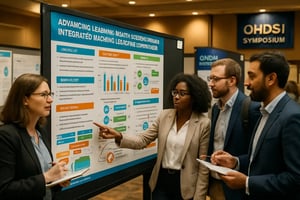At this year’s OHDSI Symposium, our team presented a poster titled Advancing Learning Health...
Open Source to Open Innovation: Rethinking Self-Service Research Infrastructure
Budgets are tightening across NIH- and CMS-funded research, and teams are being asked to do more with less. Institutions need a pragmatic way to support more investigators without growing informatics queues.
Hospitals and academic medical centers face a hard reality: you must deliver real‑world evidence faster while staff and funding shrink. The obvious question is how to keep up. At Cognome, our view is that the path forward combines self‑service tools that put power directly in researchers’ hands, plus a community model we call Open Innovation—so institutions, not external sponsors, set the roadmap.
Atlas Is Good… Until It Isn’t
OHDSI’s work to standardize observational data through the OMOP Common Data Model is invaluable. But tools like Atlas were built for de‑identified datasets and sponsor‑driven use cases. That’s a mismatch for health systems, where researchers often need to work with identified data before de‑identification, link to imaging, registries, notes, and biobanks, and operate under IRB protocols—quickly.
Where Atlas fits—and where it doesn’t
- Built for de‑identified datasets: fine for pharma observational studies, not for day‑to‑day institutional research on identified data.
- Gaps for self‑service: cumbersome UI; no cohort upload/download; no IRB protocol integration.
- Operational friction: handling identified data often means parallel datasets—cumbersome and outdated.
What institutions actually need
A researcher‑led workflow that supports identified or de‑identified data under governance; simplifies cohort work; and plugs into IRB/DUA processes—without database programming or long waits.
SEARCH Is the Self‑Service Engine You’ve Been Waiting For
Cognome SEARCH™ fills the gaps Atlas can’t cover and gives institutions a true self‑service platform they can own.
What researchers can do with SEARCH
- Work with identified or de‑identified data under governance.
- Upload and download cohorts so work never starts from scratch.
- Run cohort queries in natural language and across notes via built‑in NLP.
- Integrate with IRB, DUAs, and compliance so workflows stay aligned.
- Extract patient‑level datasets without database programming.
Designed for usability and compliance
SEARCH is immediately useful to investigators and immediately comfortable for governance teams—speed without sacrificing oversight.
Why “Open Source” Isn’t Enough Anymore
Traditional open source in research informatics often means a sponsor funds the roadmap. That can leave institutions adapting to outside priorities. Open Innovation flips this: users become the sponsors over time, shaping evolution through real institutional needs.
What Open Innovation means in practice
- Access to the source for Cognome tools like SEARCH and I/O.
- Freedom to run, extend, and modify to meet local needs.
- Shared improvements maintained by us for the community.
- User‑sponsored evolution: the institutions using the tools guide the roadmap.
A sustainable, community‑governed model
This approach supports the full complexity of healthcare data (identified records, IRB workflows, multimodal analytics) while preserving the collaborative spirit of open science. As adoption grows, we envision community governance that keeps innovation open, accountable, and mission‑driven.
Let’s Build Something That Lasts
Open Innovation is about taking ownership of research infrastructure—not by building everything from scratch, but by collaborating on shared, sustainable tools aligned to institutional goals. If you’re looking for something more usable than Atlas, more aligned with how research gets done today, and more sustainable for the long haul. If you'd like to unlock true self‑service, generate OMOP data that reflects your reality, and collaborate in a way that works—for your team, your data, and your mission: Get in touch here.





